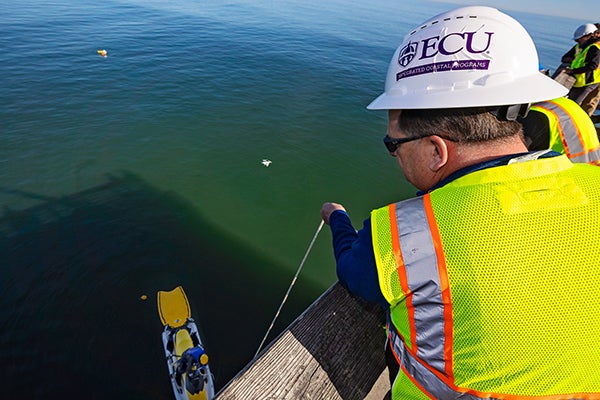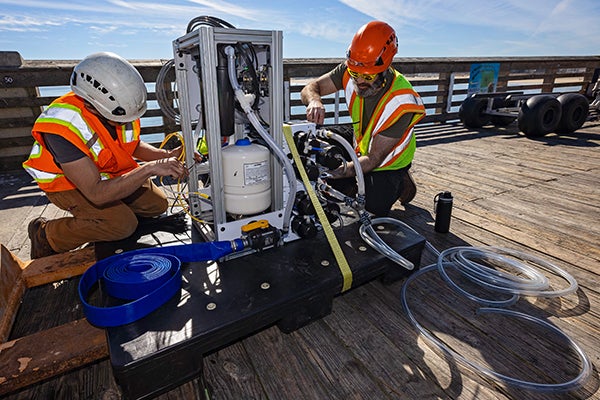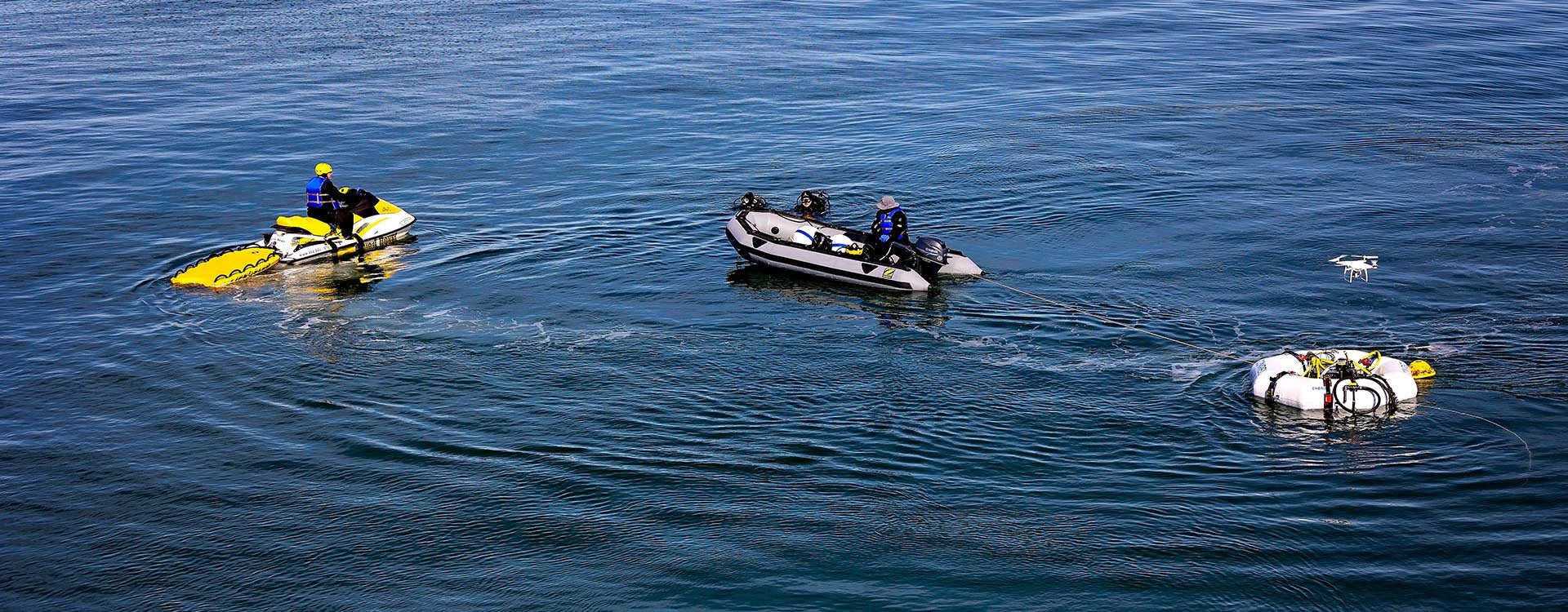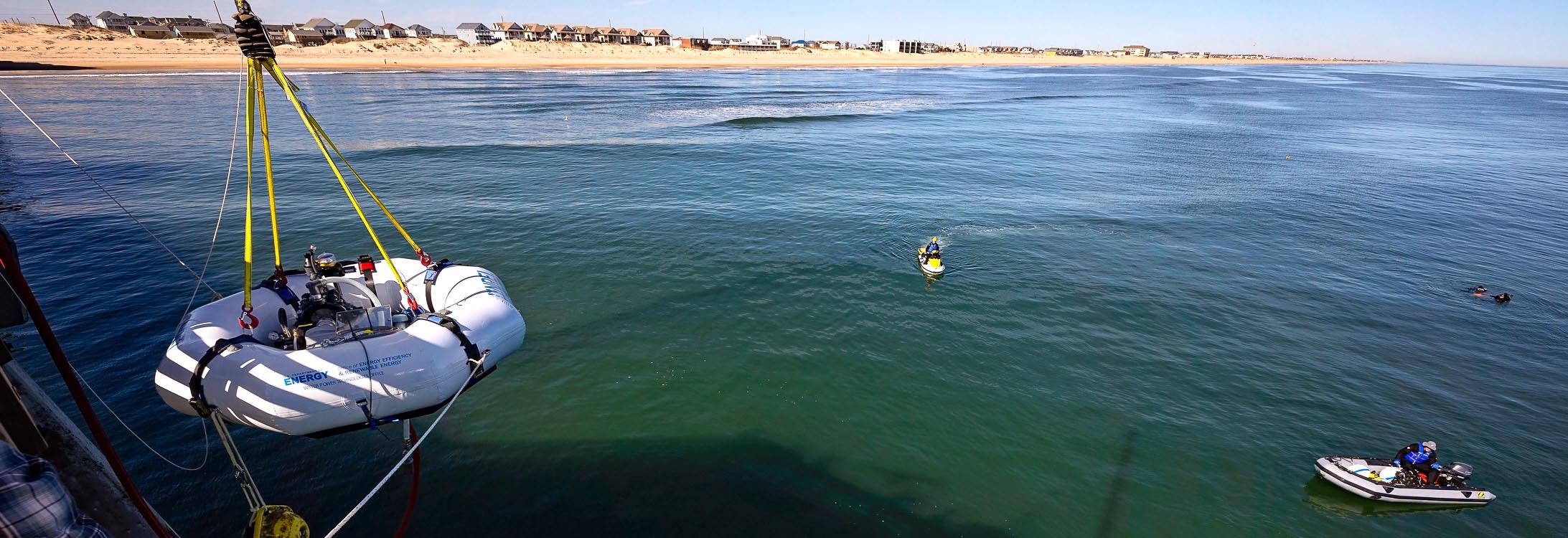TEST RUN
Researchers deploy test device for Waves to Water competition
A thousand feet from shore and 20 feet above the surface of the Atlantic Ocean, a spider crane hoists objects from the deck of Jennette’s Pier in Nags Head and lowers them into the water below — first a jet ski, then a Zodiac inflatable boat. Divers wait in the 41-degree water, then board the watercraft.
Then, carefully, researchers and engineers attach another inflatable to the crane. This one is hexagonal and filled with equipment. A hose with an intake filter dangles below. The device is towed to a nearby buoy, where it is anchored to the sea floor.
The deployment was a test run. In April, the Coastal Studies Institute, part of East Carolina University’s Outer Banks Campus, will host the final stage of a national competition called the Waves to Water Prize. The five-stage contest was created by the U.S. Department of Energy’s Water Power Technologies Office to foster innovation in the design of water desalination systems powered by marine renewable energy.
WAVES TO WATER

Researchers and engineers from ECU and the National Renewable Energy Laboratory deploy equipment in preparation for the Waves to Water Prize competition.
The Waves to Water Prize is a five-stage competition that offers up to $3.3 million in cash prizes, with a goal to demonstrate small, modular, cost-competitive desalination systems that use the power of ocean waves to provide clean drinking water for disaster recovery and for remote and coastal communities.
“The Waves to Water Prize is aimed at trying to understand disaster relief operations in areas post-hurricane and other scenarios where infrastructure has been wiped out,” said Scott Jenne, research engineer with the National Renewable Energy Laboratory (NREL). “You need access to water. So the work on this has been aimed at trying to understand how to do this quickly.”
In earlier stages of the contest, teams proposed, developed and designed systems that could be shipped in a standard container measuring just over a cubic meter, deployed in under 48 hours, and produce potable water from seawater.
Four such devices have made it to the final stage of the competition and will be deployed in April. To prepare for the deployment, NREL engineers developed their own test device and deployed it this month.
“We’re here primarily … for a dress rehearsal, if you will, something to practice with,” Jenne said. “That way, the day of the prize, we’re ready to go, since we’ll be doing this with four devices in one day.”
NREL’s test device consists of a hydraulic system that, once anchored, uses the vertical movement generated by passing waves to pump water to a reverse osmosis unit (desalinator) on the pier. The device can also be configured with an onboard generator to turn the wave energy into electricity instead of using it to pump water. Either way, the end result is potable water.
The teams will have to reduce the salinity of seawater from about 35,000 parts per million to under 1,000, which the World Health Organization recognizes as the maximum salt content to be considered drinkable water.
“At 1,000 ppm it’s going to taste salty, but you can save a life,” Jenne said. “The teams will likely produce closer to 200-300 ppm, where you wouldn’t taste the salt.”
CSI’s Lindsay Dubbs, associate director of the North Carolina Renewable Ocean Energy Program, said her lab will be responsible for testing the water for dissolved solids and documenting how much potable water is created. During the test deployment, she was also responsible for ensuring there was no negative impact on marine mammals. She and her team kept an eye out for passing whales and dolphins, prepared to stop all activity if they came too close.

NREL engineers prepare part of the test device on Jennette’s Pier.
“There was a sighting of a mother and calf right whale out in Duck yesterday afternoon,” she said. “And they’re critically endangered. So if we see it … we will be taking note.”
Minimizing the contest’s impact on sea life was one reason for deploying the devices from the pier, Dubbs said, since it avoids the disruption of animal behavior in the surf zone.
For the teams in the contest, Jenne said, there are a number of challenges. The systems must survive varied wave conditions and other issues inherent in the marine environment.
“One of the biggest challenges is going to be fatigue, just the ocean environment in general,” he said. “Every wave beats on these systems, and so trying to design these so that they can last days, weeks, months, years is the challenge.”
As an example, he said, the NREL device uses a large spring. At first, the team considered a standard garage door spring, which might have an expected lifespan of 20 years.
“But if you actually look at the number of cycles, over 20 years with opening the garage door once or twice a day, or even three or four times a day, they typically have a design life of around 20,000 cycles,” he said. “In a five-day window, we’ll see 75,000 cycles. So the fatigue challenge of wave energy is a non-trivial challenge.”
Another challenge is that the devices should ideally be able to operate effectively on calm days when the wave energy is low, yet withstand the power of a storm.
In April, the competing devices will be deployed for a five-day window. There will be multiple displays and opportunities for the public to learn about the competition and the latest developments in renewable ocean energy.

NREL’s test device is designed to use wave energy to pump water or to generate electricity.
